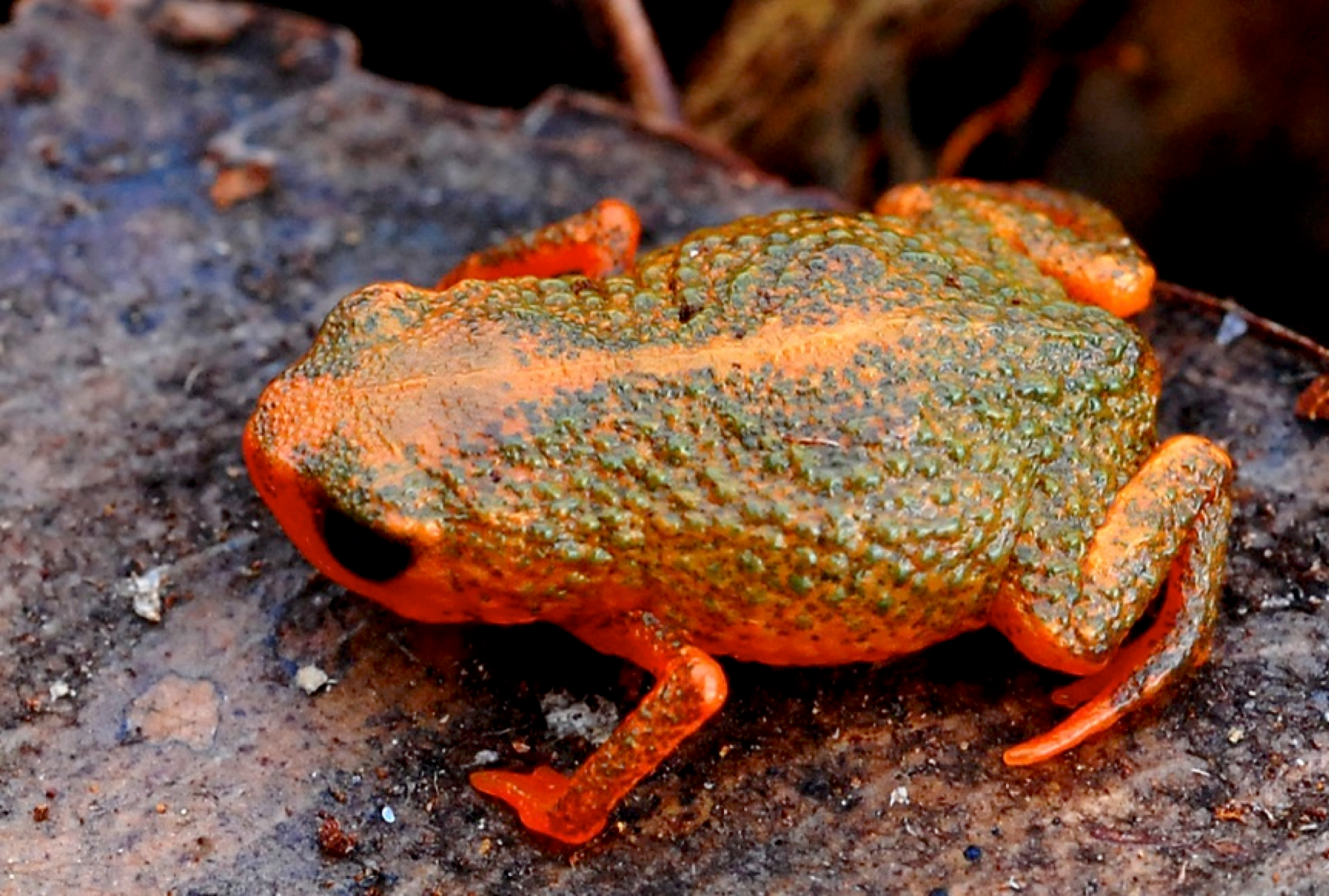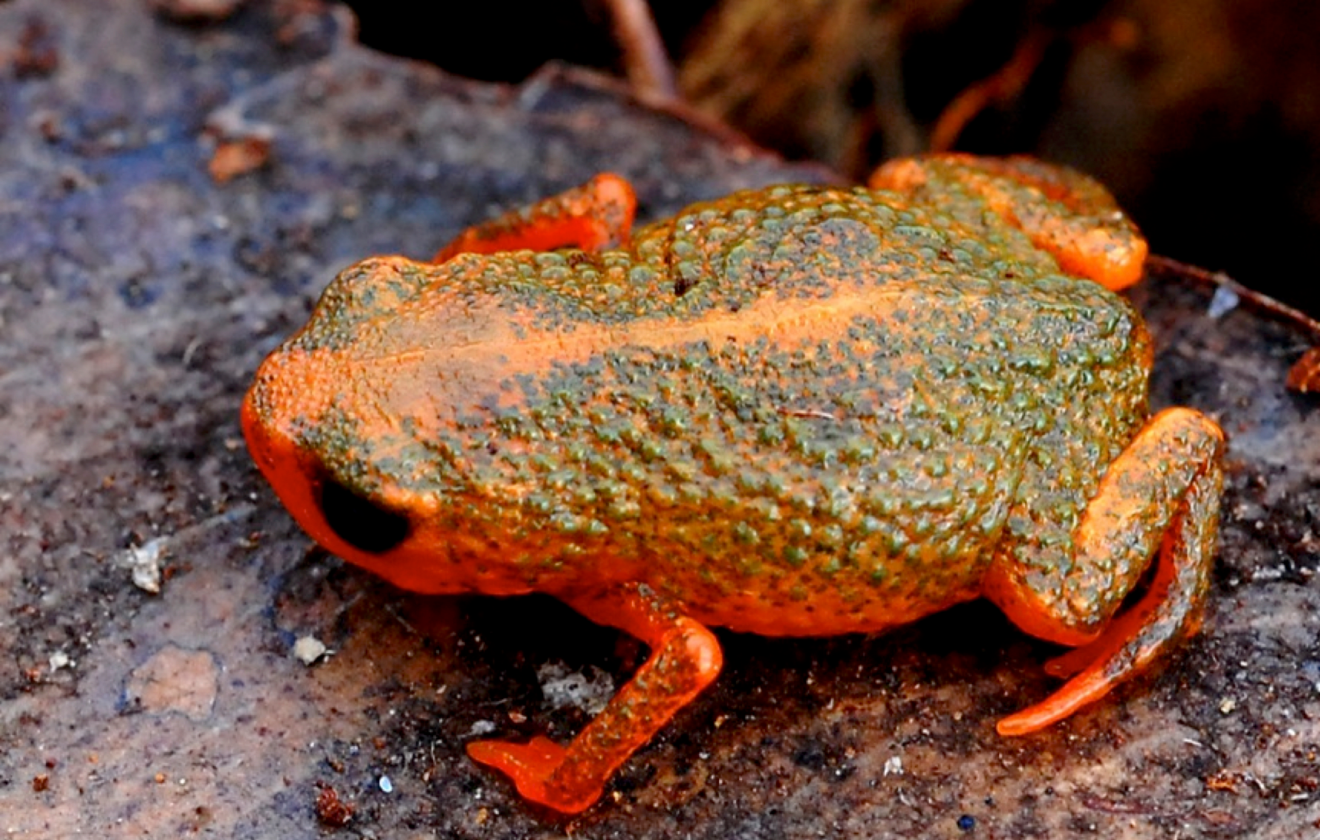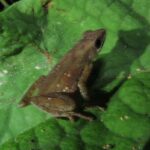- Brachycephalus verrucosus: Unveiling the Tiny Jewel of Brazil's Atlantic Rainforest
- Taxonomy and Classification
- Natural Habitat: The Jewel of Brazil's Atlantic Forest
- Portrait of a Miniature Marvel: Physical Characteristics
- Behavior and Life Cycle: Secrets in the Mist
- The Ecological Role: Small Frog, Big Impact
- Conservation and Threats: Preserving a Delicate Gem
- Cultural and Scientific Significance
- Championing the Tiny Wonders of Nature
Brachycephalus verrucosus: Unveiling the Tiny Jewel of Brazil’s Atlantic Rainforest#
Hidden amidst the lush leaf litter and mist-shrouded trees of Brazil’s disappearing Atlantic Rainforest dwells an extraordinary frog, captivating both scientists and nature lovers alike. Brachycephalus verrucosus, known colloquially as the “warty pumpkin toadlet,” is a miniature marvel whose vibrant colors and curious nature belie its minuscule size. Measuring less than two centimeters from nose to rump, this tiny amphibian packs an astonishing evolutionary punch, boasting unique adaptations that intrigue researchers and conservationists worldwide.
Though small and easily overlooked, Brachycephalus verrucosus has rapidly become emblematic of Brazil’s critical biodiversity crisis. By stepping into its enchanting habitat, we can unravel the secret lives of these charismatic micro-creatures, discover their vital ecological roles, and understand why protecting their fragile forest homes is essential for global biodiversity conservation.
Taxonomy and Classification#
Brachycephalus verrucosus belongs to the family Brachycephalidae, a fascinating group of miniature frogs endemic to Brazil. Within the diverse genus Brachycephalus—which includes over 30 described species—each member exhibits distinctive adaptations shaped by their isolated habitats. Officially described by Ribeiro et al. in 2015, this tiny amphibian represents one of the newest additions to scientific literature, reflecting our continually expanding understanding of rainforest biodiversity and underscoring the urgency of protection efforts.
Its scientific name, Brachycephalus verrucosus, stems from Latin origins: “Brachycephalus” meaning “short-headed”—a nod to the compact and flattened shape typical for this genus—and “verrucosus,” referring to its defining characteristic: distinctive wart-like skin formations adorning its back and limbs. Though closely related to other vibrant “pumpkin toadlets” like Brachycephalus ephippium, this species’ particular wartiness and coloration set it distinctly apart.
Natural Habitat: The Jewel of Brazil’s Atlantic Forest#
Step quietly beneath the dense canopy of the Brazilian Atlantic Rainforest, and you enter a realm of perpetual twilight—a moist, humid sanctuary where every leaf, log, and stone shelters an incredible array of hidden life. Here, amidst the moss-covered fallen trunks and dense layers of foliage in montane rainforest sites of São Paulo state’s Serra do Mar mountain range, Brachycephalus verrucosus finds its exclusive home.
This endemic frog favors high-altitude cloud forests between approximately 800–1,200 meters in elevation. These unique ecosystems, characterized by frequent fog, high precipitation, cool temperatures, and lush layers of bryophytes and leaf litter, create an environment perfectly suited for such miniature amphibians. Thriving in the moist floor-layer microhabitats, these frogs play a subtle dance with survival, remaining hidden from predators yet strategically positioning themselves within microenvironments precisely adapted to their needs.
The rich biodiversity of their home fosters a complex web of life—dense vegetation shelters an incredible array of insects, spiders, fungi, and microbes upon which the web of rainforest relationships depends. Wandering through this realm, you feel a sense of timelessness, knowing that amidst this verdant bounty, tiny beings like Brachycephalus verrucosus quietly contribute to forest equilibrium, demonstrating that even the smallest creatures possess invaluable ecological roles.
Portrait of a Miniature Marvel: Physical Characteristics#
Brachycephalus verrucosus’ appearance leaves a vivid impression despite—or perhaps because of—its remarkable miniature stature, typically measuring a mere 1.2 to 1.6 centimeters in total length. Their diminutive build makes them one of the smallest terrestrial vertebrates worldwide. Yet, what they lack in size, they compensate for with visual strikingness, possessing a body decorated with vibrant colors ranging from bright yellows and oranges to occasionally deeper red-orange hues.
The most characteristic feature of this species, and indeed what inspired its name “verrucosus,” is the presence of conspicuous wart-like protuberances covering its dorsum and limbs. These bumpy textures, coupled with its fiery color scheme, may serve essential defensive roles, signaling toxicity to would-be predators, warning them of unpleasant experiences should they decide upon an attempted predation.
Besides wartiness, these frogs also possess reduced digits and limbs, adaptations perfectly tailored for their terrestrial lifestyle. Indeed, their short, robust limbs make them poor jumpers, forcing them instead to navigate subtly amid leaf litter and organic debris on the forest floor, relying heavily on camouflage and chemical defenses rather than fleeing threats through agility.
Each physical characteristic—the tiny build, intense coloration, wart-covered skin, and compressed digits—offers deep insight into their evolutionary history and ecological strategy in enduring the demanding rainforest ecosystem.
Behavior and Life Cycle: Secrets in the Mist#
Life in the Atlantic Forest leaf litter requires subtlety and precision, both of which Brachycephalus verrucosus exhibits admirably. As a diurnal species, these frogs utilize daylight hours to forage for tiny arthropod prey such as mites, ants, springtails, and small beetles. Their feeding strategy relies primarily on stealthy ambush tactics, patiently waiting in concealed locations until prey comes within striking distance, then swiftly extending their short, sticky tongues to catch their meal.
One of the most extraordinary aspects of their biology involves their breeding behavior. Like other species within the Brachycephalidae family, Brachycephalus verrucosus bypasses the flagellated tadpole stage altogether—a phenomenon scientifically termed as “direct development.” Instead, females carefully deposit fertilized eggs directly onto moist soil or concealed leaf-litter microhabitats, where they undergo full embryonic development inside their protective gelatinous capsules.
In due time, fully formed froglets emerge directly from eggs—tiny perfect replicas of their parents, independent and ready to face the forest world. This remarkable life-history strategy spares them the perilous aquatic larval stage, yet heightens their vulnerability to disturbances in terrestrial habitats. Indeed, their survival depends heavily on the preservation of specific moisture and temperature regimes prevalent within stable microclimates of pristine forest ecosystems.
The Ecological Role: Small Frog, Big Impact#
While small, Brachycephalus verrucosus occupies a significant ecological niche within Brazil’s montane Atlantic Forest ecosystems. Acting as both predator and prey, these tiny amphibians help regulate insect populations, contributing to a delicate ecological balance that governs the overall health of their habitat. Their diet of tiny arthropods directly affects rainforest decomposition rates, nutrient cycling, and pest regulation.
Equally important is their role as a prey species. Though brightly hued to advertise potential toxicity, predators adapted to handling toxins—such as certain snakes, large invertebrates, and birds—still target them, intertwining their existence into a complex food web that underpins the broader ecological stability.
Furthermore, as highly sensitive amphibians, their population health provides a vital lens into overall environmental conditions, serving as bioindicators that alert scientists and conservationists to subtle yet critical shifts in forest ecosystems caused by climate change, habitat degradation, or pollution stresses.
Conservation and Threats: Preserving a Delicate Gem#
Beautifully adapted yet perilously sensitive, Brachycephalus verrucosus faces multiple threats that continue to jeopardize its existence. Accelerating habitat loss due to logging, agricultural expansion, urban development, and mining drastically shrinks their already limited geographic distribution. Forest fragmentation isolates populations, hampering genetic flow and increasing susceptibility to localized extinctions.
Though conservation assessments continue to evolve given its recent scientific description, the International Union for Conservation of Nature (IUCN) currently lists many closely related species as “Critically Endangered” or “Endangered,” reflecting vulnerability to extinction pressures across the genus. Urgent conservation actions—including habitat protection, ecological corridor creation, and habitat restoration initiatives—are essential to safeguard this invaluable biodiversity asset.
Cultural and Scientific Significance#
Beyond ecological value, species such as Brachycephalus verrucosus offer immense cultural, aesthetic, and scientific significance. Their striking appearance and elusive nature inspire local legends and folklore, serving as regional symbols for conservation efforts promoting pride and protection for Brazilian biodiversity.
From a scientific view, studying these diminutive frogs enriches our understanding of evolutionary biology, amphibian ecology, toxicology, and global biodiversity patterns. Every discovery, from novel chemical compounds present in their skin to behavioral adaptations, adds layers to humanity’s collective biological knowledge.
Championing the Tiny Wonders of Nature#
Exploring the captivating life of Brachycephalus verrucosus highlights the extraordinary complexity and wonder found in edges easily overlooked. Preserving their forest homes and protecting this remarkable species becomes paramount to safeguarding Earth’s broader biodiversity. By recognizing the significance embedded even within nature’s tiniest creatures, we reinforce efforts and commitments toward responsible stewardship, ensuring that nature’s treasures continue igniting curiosity and wonder for generations yet to come.








